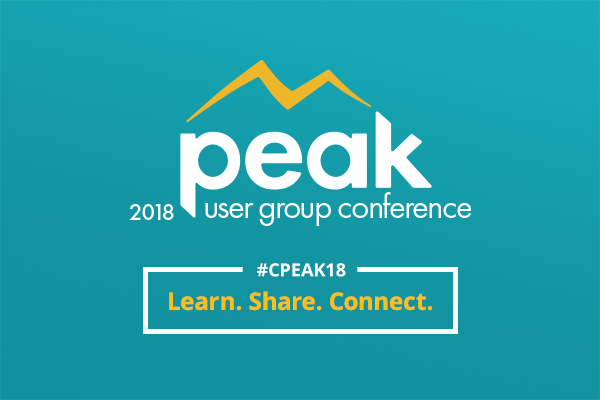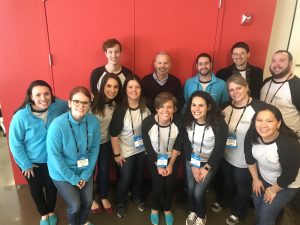
by Rich Finstein | Apr 5, 2018 | Blog
A year ago we made the decision to host our first User Conference. Since this was our initial event, we had some trepidation about whether our community would embrace the opportunity to join us for several days of education, training and networking. Our decision to move forward was quickly validated as we reached the maximum number of attendees we could accommodate in the venue.
When the first day of the conference arrived, we were excited to see in-person the people we interact with on a daily basis. As I began the initial welcome, I mentioned to the group that this felt more like a social function as opposed to a business event. There was a warm feeling that comes when relationships evolve over time and there is continuity of working with the same team to share opportunities and solve problems. For our team, this conference was an important barometer of where we stand. It’s one thing to have one on one interactions, however it’s an entirely different situation to see many of your clients in one setting. We feel extremely blessed to have had this opportunity.
There are three insights that we walked away with from the event:

Click to view photos from Peak 2018.
- We have a vibrant community that has evolved organically with us over a long period of time. There are no shortcuts in getting to this point. CommPartners has an average employee tenure of 8 years with many staff being with us for 12 to 15 years. At times, we don’t think about how important a factor this is in building close client relationships that lead to greater continuity and trust. You could witness this in real time during the conference.
- Peak served an important purpose of facilitating ideas and proving attendees practical applications they can implement today. One of the greatest benefits was the sharing of best practices and hearing how people in the same position overcome day to day challenges of managing professional development within their organizations. We realized we need to keep this conversation going and not wait until we meet again. Therefore, we launched a number of initiatives to give voice to our clients and allow for ongoing engagement. They include:
- Elevate Advisory Board: This is a 13 member panel group made up of mostly clients to provide guidance and feedback on Elevate’s development, provide feedback on our services and share ideas with other Board members.
- CommPartners Mastermind Groups: These groups bring clients together for 4 sessions to engage around topics of leadership, creative thinking and professional growth.
- CP Connect Community: CP Connect is an online community. It will be launching shortly to continue the conversations and sharing of ideas that occurred at Peak.
- CP Cares: We are expanding our altruistic initiatives to support those in need. We are hoping to involve our clients in these efforts.
- We need to continuously come through for our community. You depend on us. This was evident through the passionate conversations that occurred at the conference. We understand this responsibility. In the coming year we have aggressive plans to bring innovation, additional resources and service enhancements to our clients. We’re excited about growing with you and helping you succeed.
If you have any additional feedback or thoughts about Peak or any other items, please contact me.
All the Best,

Rich Finstein

by Aubrey Mellos | Mar 5, 2018 | Blog
Guest blog by Bobby Kaighn, Higher Logic
Online learning is valuable, convenient, and scalable, which makes it an ideal benefit for associations. In the last few years, online learning has also proven to be very popular for members who want to advance their careers.
But many online learning programs aren’t as effective as they could be. Most courses are meant for individuals, which can feel isolating to some members, while other learners may find it difficult to apply online concepts in their daily lives.
Online learning communities can help.
By pairing your online learning programs with an online community, you can improve the member experience and help information stick, which will make your programs more effective. It could even boost enrollment.
Here are four ways community can improve online learning.
Four Ways An Online Learning Community Can Improve Your eLearning Program
1. Community Discussions Keep Learners Engaged
Coursework, no matter how interesting, can be tiring. An online learning community adds an interactive element to elearning courses, including peer discussions, file libraries, blogs and emails.
Learners can use these tools to connect with their peers and start conversations about course topics. They can also ask questions and share their thoughts on how course material relates to their lives. All this interaction helps learners engage with your courses and can make the material in them more meaningful.
2. Peer Support Helps Learners Complete Courses
Unlike traditional education, online learning doesn’t have a built-in support system. You can’t walk up to a professor after a lecture to ask a question or form a study group with friends. In online learning, if someone gets stuck on a challenging concept or loses motivation to complete the program, there may not be anyone around to help.
With an online learning community, you give learners that network of peers. You give them a space where they can connect with peers who are also working through the same course and can help them through difficult material. Participants can ask for help publicly through discussion forums or use private email if they don’t want to open their concern up to the group. Their peers can also help motivate them to finish through conversations or by sharing helpful material, just like they would have in a traditional learning environment.
3. Community Mentoring Programs Help Learners Apply New Skills
Many associations use online learning programs to help members with professional development. With an online community, you can add practical experience to online concepts through a mentoring program.
Learners can either sign up for a mentor while they’re taking the course or after completing the program. Their mentor will then help them apply course concepts in their daily lives, giving them advice and tips based on experience.
By using a community mentoring program to help learners apply course concepts, you make it more likely that they’ll remember and use what they learned. That, in turn, translates to members getting more value from your programs.
4. Community Networking Extends Engagement After Learners Finish Courses
Traditional education uses networking tools like class reunions and alumni groups to build deeper, long-term connections between students and organizations. Often, those connections result in generous financial or advocacy commitments to schools.
Your association can use an online learning community for similar benefits. Build a community for your learning program alumni so they can continue networking and stay involved with your association after their courses are over. They can use their new connections to provide continued support, pursue job opportunities, and more. This long-term networking will also help keep your association and its programs top of mind, which could lead to future referrals as alumni find new people who could benefit from your programs.
Use Community to Improve Your Online Learning Programs and the eLearning Experience
Online communities provide the social element that’s often missing with online learning programs. They allow learners to connect with peers, share their thoughts, and get the support they need for a successful educational experience.
And, by improving your online learning programs, you also increase the value members get from your association, making it more likely they’ll stick with you and refer their friends and family.
Some associations choose to invest in a learning management system to create an online community and promote collaboration between learners. If you would like more information on how to create quality educational experiences that engage and inspire the learner, give us a call at (800) 274-9390 or fill out our online contact form to get in touch with someone.

by Aubrey Mellos | Feb 23, 2018 | Blog
Guest Blog from our Partners at ExpoLogic
Sessions make up a significant part of your event’s agenda and can be a deciding factor for attendees when choosing to come to your event. It is important to select sessions that are exciting, interesting, and engaging to ensure your event’s success.
But how do event organizers know what sessions attendees are interested in and what topics they find relevant?
Tracking session attendance is an easy and accurate way to gather attendee feedback and translate this information to useful data. Feedback from attendees on the sessions offered can be incredibly valuable when it comes to planning a successful event and deciding how to make the attendee experience more meaningful.
Here are 5 reasons why you should start tracking session attendance at your next event:
- Understand your attendee’s interests – Tracking session attendance gives event organizers important insight on what topics their attendees find interesting and captivating. Session tracking data identifies how many people enter a session, leave a session, and how long they spent in the session. This data can be analyzed and used when selecting session topics and speakers for future events.
- Award education or professional credits – Identifying the amount of CEUs or CMEs to award session attendees is no longer a challenge when using session tracking technology. Event organizers can accurately report this information with the data obtained from the session tracking technology.
- Measure your investment – Understanding which sessions your attendees are spending the most time in allows you to better measure the investment made on speakers and session material. Session tracking data can be used to evaluate which topics, speakers, and overall sessions are popular with attendees and if they are worth bringing back again in the future.
- Focus on your event budget – Event organizers can better plan their budget with the data provided from tracking session attendance. If sessions are empty or attendees are consistently leaving early, remove these sessions from your agenda and use the funds in other areas to help improve your event.
- Adjust sessions to improve future events – Session tracking data provides details about attendees that can help organizers when planning an event. Information such as number of unique attendees and average dwell times can measure the level of attendee interest for each session letting you plan more efficiently. For example, a session with higher attendance rates can be designated to a larger room to better accommodate the demand.
If you aren’t tracking sessions at your event, you are missing out on valuable information that could help improve your event. Start tracking sessions and use this information during the event planning process. Session tracking data can help you create a well-planned agenda with engaging speakers and session topics that attendee’s will be excited to participate in.
To learn more about how to get started, visit www.expologic.com/session-tracking-expo-logic.

by Rich Finstein | Feb 9, 2018 | Blog
Last year was a period of great movement with technology providers within our community. There was an increase in merger and acquisition activity as organizations sought to extend their presence and gain strategic advantages and market share. While some may tout that bigger is always better when it comes to technology, there is a flipside to the equation. Some mergers or acquisitions do in fact work out very well for the customer however there are others that primarily benefit the company.
I began thinking about all the examples of where bigger or well-funded is not better. One service I and many others use on a weekly basis is dry cleaning. Several years ago Zips, the well-funded, national cleaners came up with a new pricing plan where they were going to charge the same low fee for every garment and promise same day service. Hearing this, I left my local cleaners, the one I went to for years, whose name literally is “Cleaners” to try this new concept. After all, Zips had a big presence; they were growing and seemed to offer great value.
After being with Zips for six months, I just recently returned to my local option. Zips always had long lines, they damaged some of my clothes, and the staff changed often. I never got to know them or build trust. In the end, it cost me more and I was treated like a number, not a loyal, valued customer. Returning to “Cleaners” I now get in and out quickly and my clothes are nicely cared for and returned in great condition. Not to mention, I am greeted with the same friendly face each time I return.
So what does dry cleaning have to do with technology? Not much really… except that for associations, trust, understanding, and continuity are significant factors when choosing a strategic partner. The best technology option is the company that allows you to successfully meet your objectives.
When considering a new LMS technology partner, be sure to ask meaningful questions such as:
- What percentage of your budget goes into the development of your software or services vs sales, marketing or distribution to shareholders?
- How would you define your company culture? Will the people I am speaking with today, who are making promises, be here tomorrow?
- What challenges are you currently addressing? How does your solution make my organization better?
- Have you recently been involved in a merger or acquisition? Can you describe how this will affect your current product or service offerings?
We have seen examples when mergers occur, the people you built trust with are gone and the platform or solutions you are invested in are no longer evolving. At CommPartners we have grown organically and with a shared purpose with our staff and extended community. We believe strongly in a culture of responsiveness, centered on the client.
Yes, many mergers or acquisitions, when handled well can greatly benefit the client and simply makes sense. However to say in all cases that bigger is better is just not true. Thank you “Cleaners” for always being there. Sorry I was swayed by bigger is always better.

by Aubrey Mellos | Jan 4, 2018 | Blog
The truth is that all subject matter experts don’t always make great speakers. Additionally, some people can deliver a killer in-person presentation but fall short when presenting to a virtual audience. We’ve compiled a few webinar presentation tips that will help ensure that your webinar speakers are equipped to deliver an amazing and memorable presentation experience:
Our Top 6 Webinar Presentation Tips for Speakers
- Deliver on the expectations of the learner – provide solutions, education, and inspiration. Leave your attendees with key takeaways and action items. But be sure to make it entertaining – tell stories, speak to personal experiences, include video or bold imagery. Case studies or real-world scenarios also work really well to help illustrate points.
- Encourage speakers to have personality and add energy. It can sometimes be awkward when you have to present to your computer screen and you don’t have an in-person audience to infuse natural energy. Consider having another person in the room so the speaker feels like they are talking to an audience. Standing up to present (with the right headset to ensure audio quality) can also help ease a presenter who is more used to in-person events.
- Speak the language of your audience. When preparing your webinar presentation, know who is on the webinar – their role, industry, department, etc. If you have a varied audience, that is okay, but be sure to acknowledge that on the live webinar and set the expectation that some of the content may not be completely applicable. This is also a great way to encourage post-event follow-up if you are unable to address specific audiences.
- Remove the fear of presenting. Presenting can be scary and doesn’t always come naturally. Layer that with a presenter that isn’t all that tech savvy and we may have a recipe for disaster. Consider having another voice to help moderate and make the presenter more comfortable. Always have a training session on the technology before the live presentation to reduce fears about how the webinar platform works, or consider hiring an event production company so that presenters can simply focus on delivering content. Lastly, always do a thorough sound check – bad audio can ruin the best presentation.
- Create a slide deck that encourages engagement. The following list includes our favorite tips on how to prepare a webinar presentation slide deck that people will pay attention to:
- Include polls, breaks for questions, or even encourage attendees to openly use the chat window to share ideas. If the speaker is comfortable they may even address some comments on the live webinar.
- Know the flow of the presentation and your story.
- The webinar should address ONE thing. Don’t try to cram too much into a webinar, you will lose your learner and will simply run out of time.
- Avoid cobbling together a presentation from old decks – start with the narrative first, then build the presentation.
- Leave time at the end for questions and conversation. This can be a great way to infuse the participants own personal experiences around the topic.
- Rehearse – but not too much! Know your narrative in and out, but don’t rehearse to the point that the delivery feels rigid. Rehearsing will also help boost the confidence of the presenter. Comfortable, interactive, and confident speakers top the list of how to ensure your next webinar will be a success.
Need Help Managing Your Webinars?
As a webinar production company, CommPartners has 25 years of experience helping to enhance and advance our clients webinars. We hope these webinar presentation tips will help your speakers deliver an outstanding and memorable learning experience! If you’re looking for someone to manage your webcasts, fill out our online contact form or give us a call at (800) 274-9390 to see how we can help.
Want to talk about how you can take your webinars to the next level? Explore our learning management system, Elevate. Give Meghan a call at 443.539.4851 or email mgowen@commpartners.com for more information.








